Last year, an unbearable number of Canada geese decided they liked our big lawn. We didn’t like them, or what they left behind. Shouting didn’t make them go away, running at them was a joke. But we knew that if our lawn was to be usable, the geese had to go.
I asked anyone I could for advice and learned that nothing much seemed to work. A spray used by golf courses did the job for a while but it smelled so bad that no one wanted to outside, which defeated the purpose. Plus it was expensive and had to be applied after every rain. I did discover, though, that Canada geese don’t like long grass. So we decided on the simplest solution. Let the grass grow and hope for the best.
My husband saw this as a cheap and practical solution to a problem. I saw it as an opportunity. Converting a long-established lawn into a country meadow appealed to me, particularly since I believed it could be beneficial ecologically. But would it work? Everything I read suggested that creating a meadow was a long and difficult process. But since letting the grass grow and seeing what happened meant leaving nature in charge, it seemed worth a try.
Early this spring, we cut the lawn once, to mulch the leaves that had stayed there all winter. Since then, we’ve mown only a walking path. The change is startling. From a smooth lawn that looked like this ….
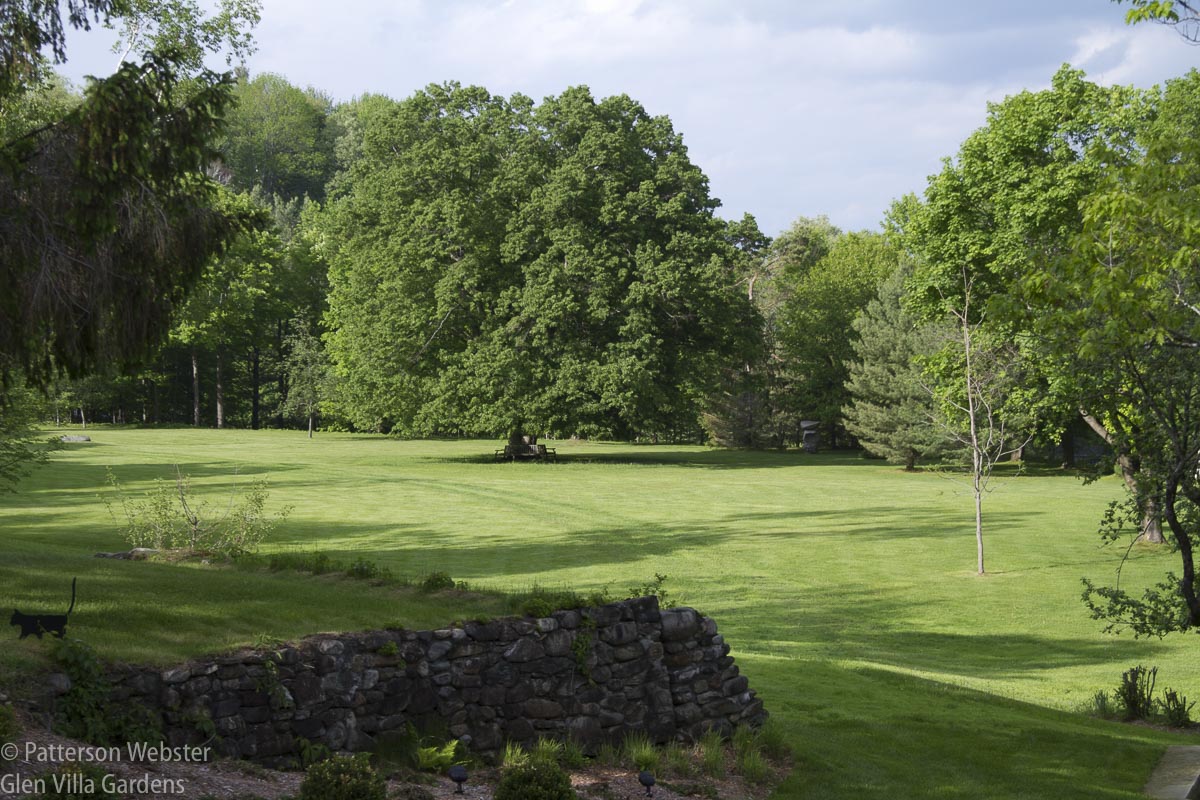
This was the view from the house out onto the big lawn in May 2015. The path in the grass was the result of heavy equipment crossing the lawn earlier in the spring.
we’ve gone to a lawn that could soon be called a field.
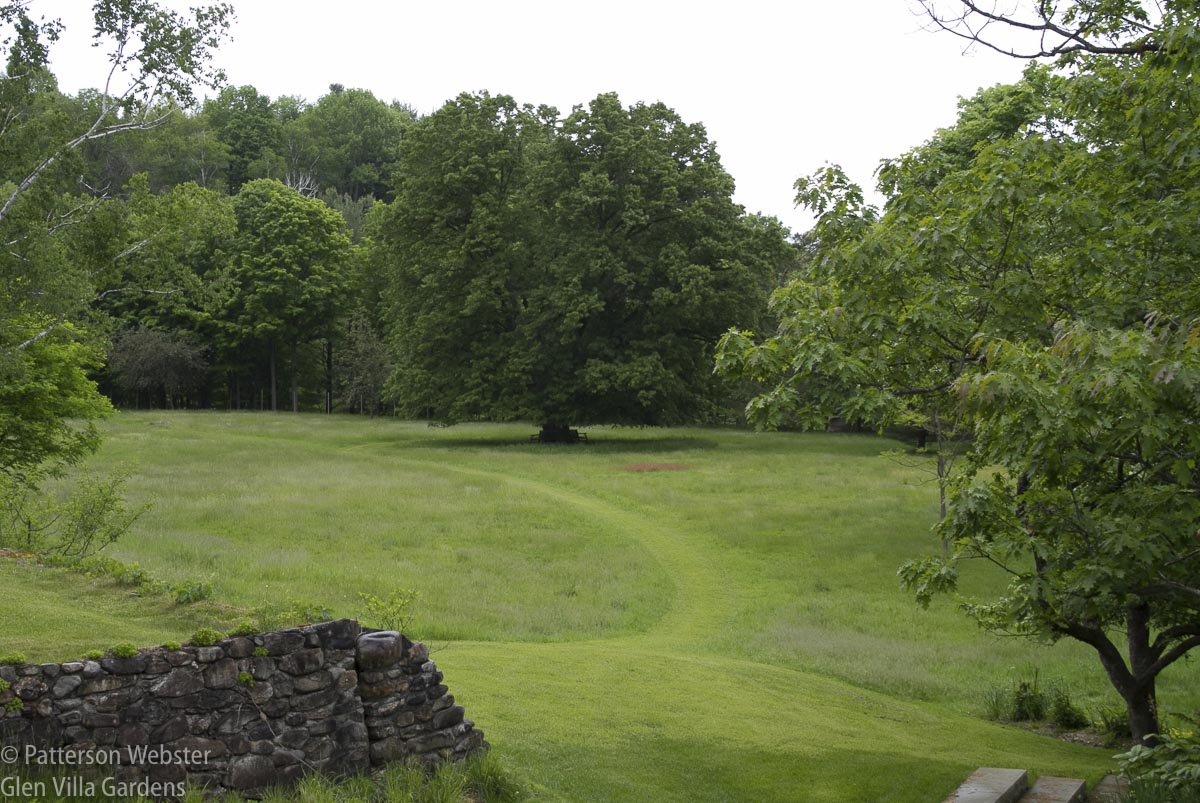
The mown path provides contrast as well as a place to walk. Once the foliage of the muscari planted under the linden tree dies back, we will mow a circle around the tree to give it pride of place.
This weekend I returned to North Hatley for the first time since early May. After being gone for a month, I knew that the grass would be taller. Even so, coming around the bend on the driveway I expected to see a variation of this familiar scene.
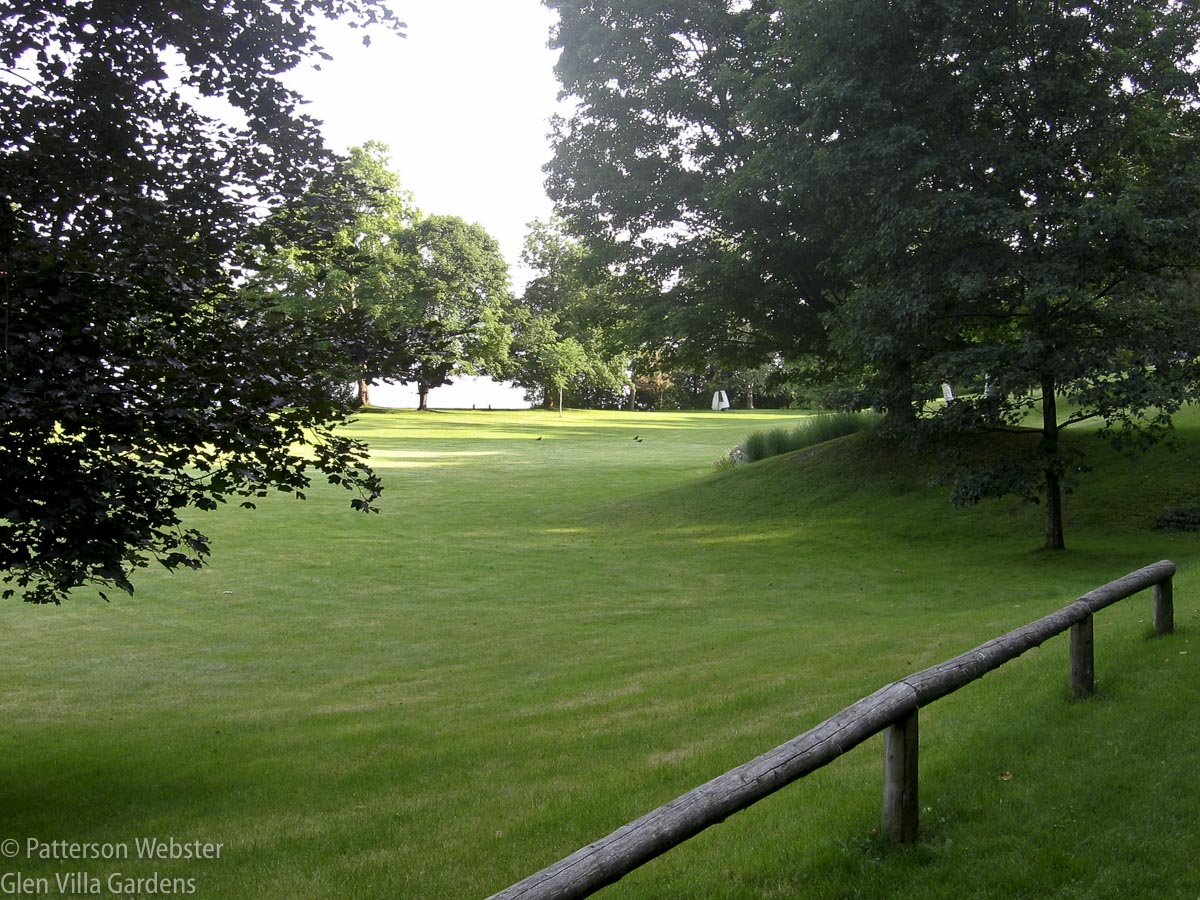
This photo is from August 2007. It’s not a very good photo but nine years ago I was using a little point and shoot camera. This image tells me that a better camera takes a better picture. And perhaps after nine years of regular photo-taking, I’ve actually learned a thing or two.
What I saw was a shaggy lawn that made me question whether we were doing the right thing.
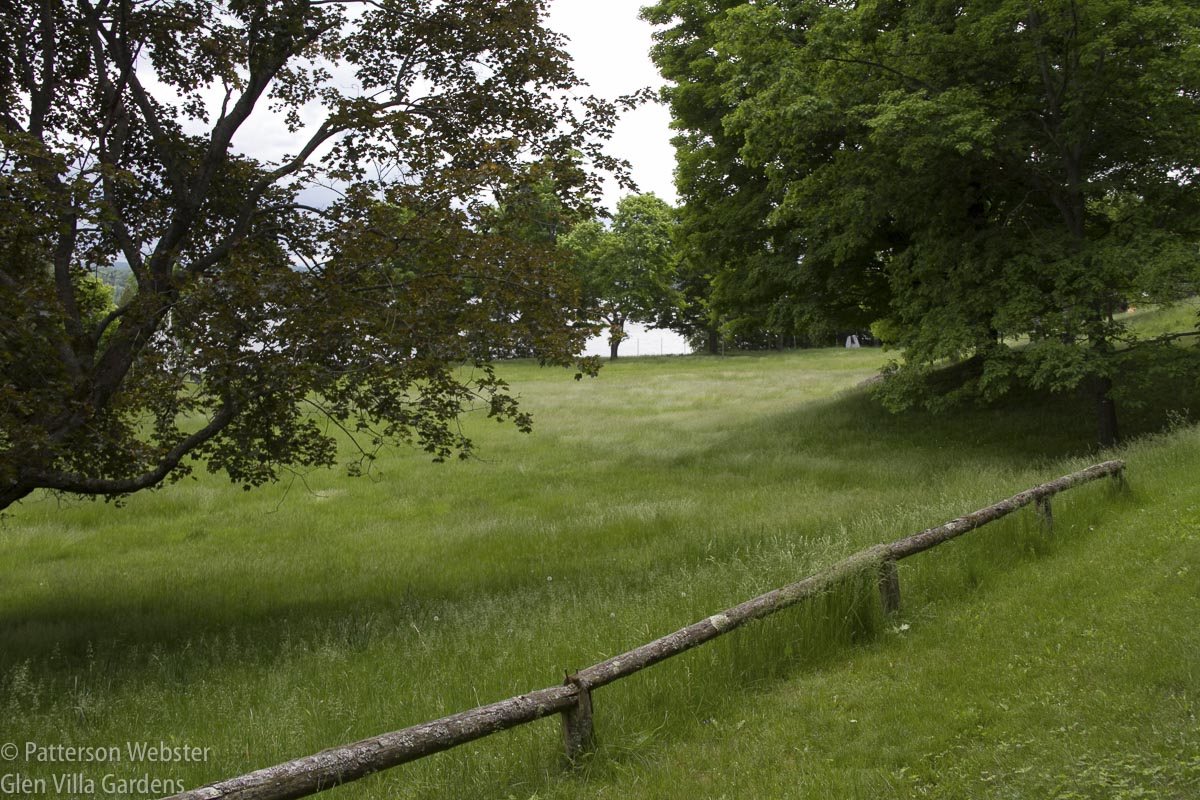
The sculpture in the distance is in the same place as in the previous photo, as are the railings on the drive. The trees have grown — but not as much as the grass.
A few days of looking has convinced me that we are. I’m amazed at the treasures that were hiding in the lawn, never able to show off their beauty. Like this mix of ragged robin, buttercups and forget-me-nots.
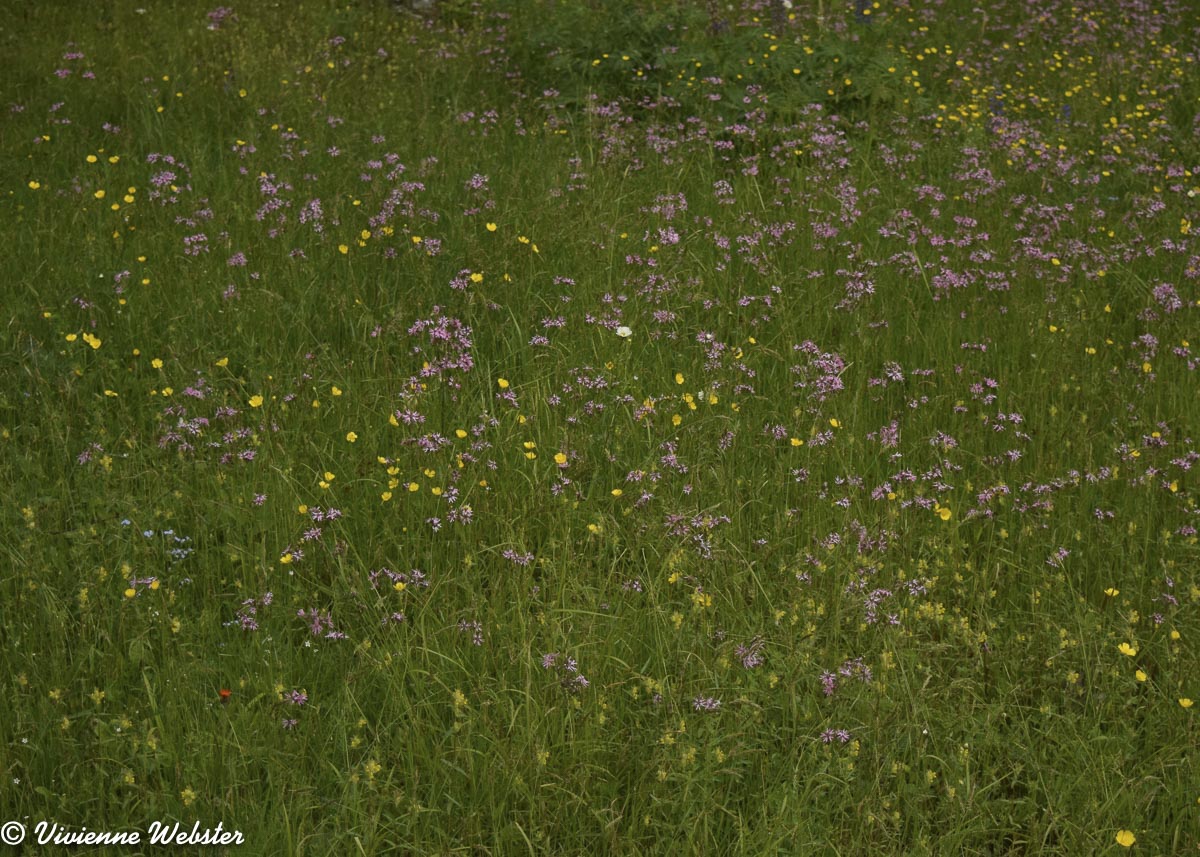
This photo and most of the others in this blog post were taken by my granddaughter. Thank you, Vivienne!
Or this grass, for instance.

I’m sure someone can identify the grass. Whatever its name, the purple tones are stunning.
Or this lovely little white flower, which many would call a weed.
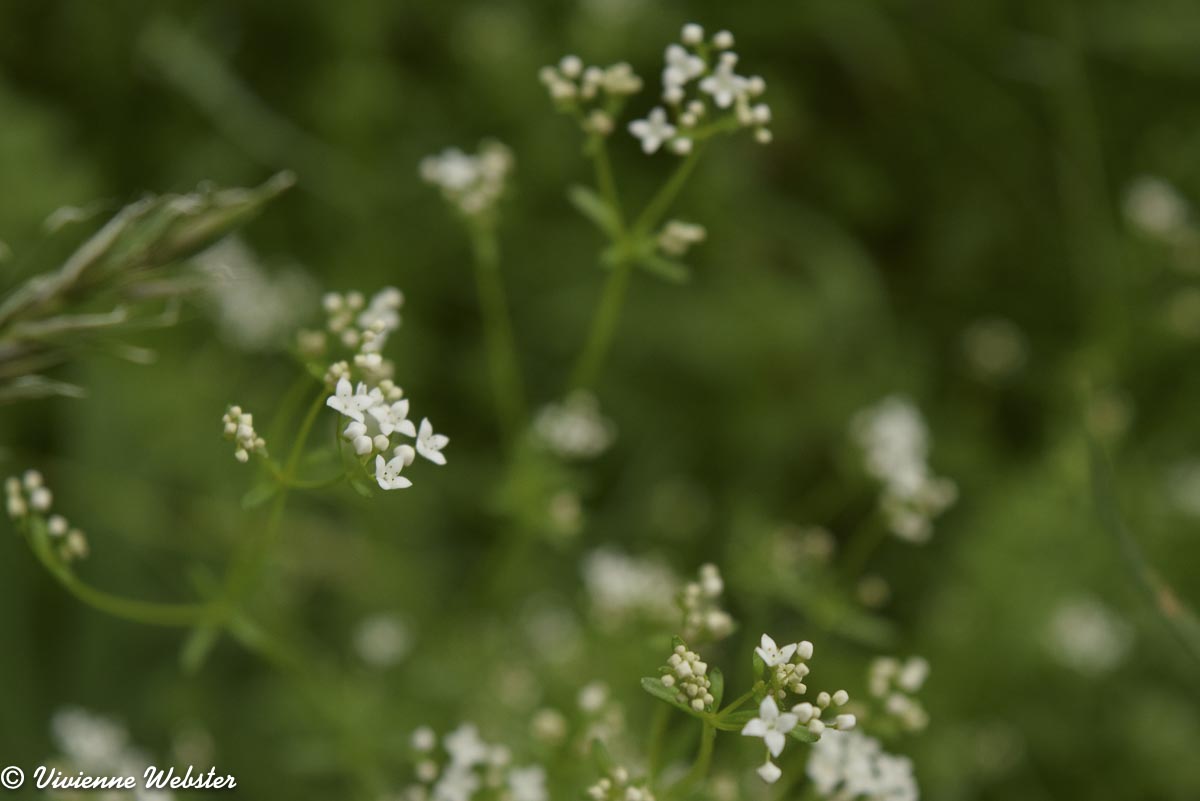
I think this is Galium palustrum. Please let me know if I’m wrong.
The most startling change is the patch of red growing in one or two sections of lawn. It was the first thing I noticed, and the first thing I went out to investigate.
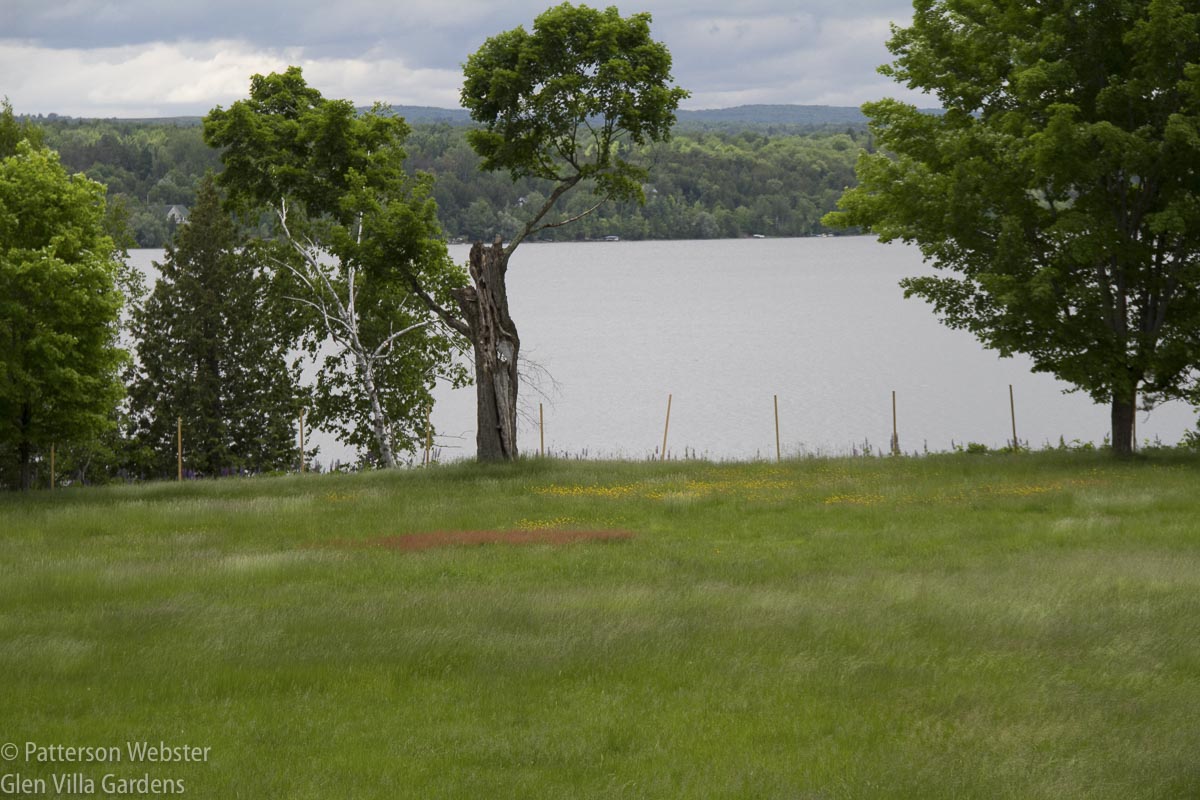
The fence in the distance is to prevent the Canada geese from coming onto the lawn with their babies.
It’s growing in a clearly defined area where, I suppose, the soil suits it perfectly.
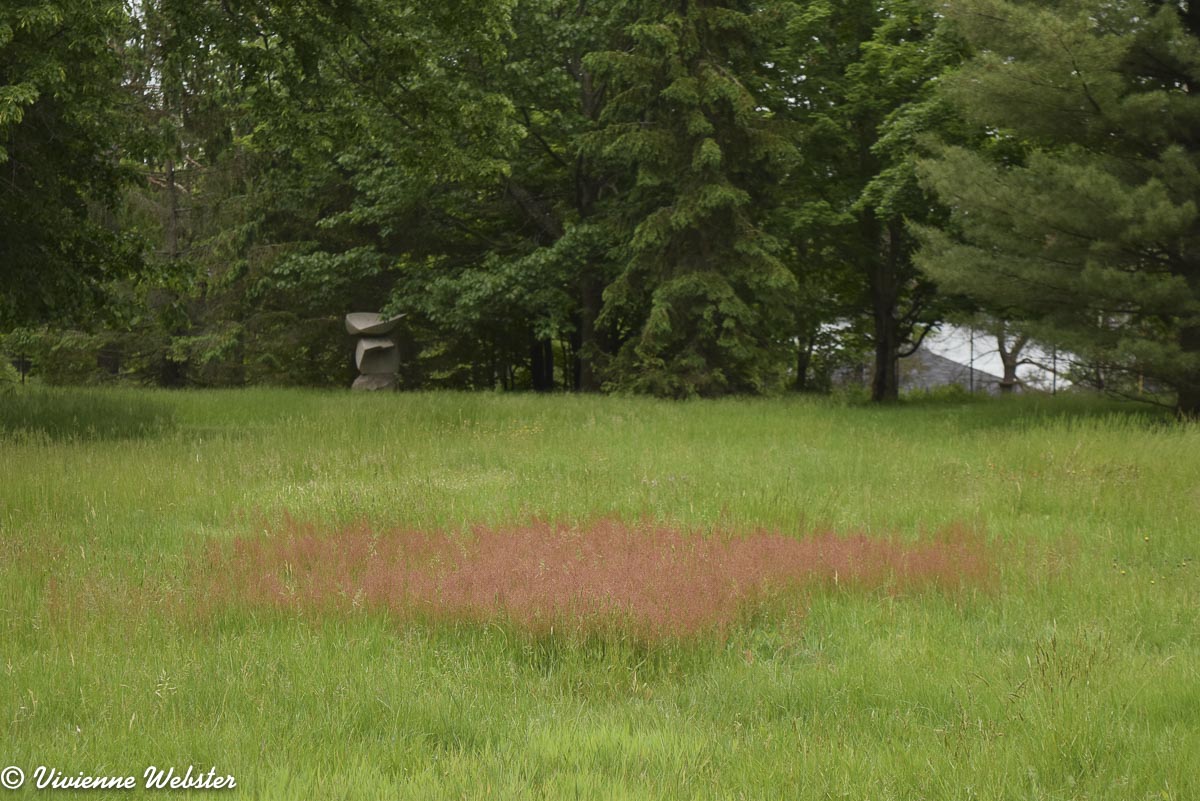
The sculpture in the distance is called Récolte. It is by local sculptors Louise Doucet and Satoshi Saito.
Will it spread to cover the lawn/field with a red haze? And what is it? This photo taken by my granddaughter shows that regardless of its name, it is beautiful.

Hazy red is not what I’d expected to see on the lawn, but I like it.
A close-up allowed us to identify it — red dock, or sheep sorrel (Rumex acetosella). Last week I saw it growing in England, in gardens and along the roadside, and I was delighted to find it thriving here at Glen Villa.
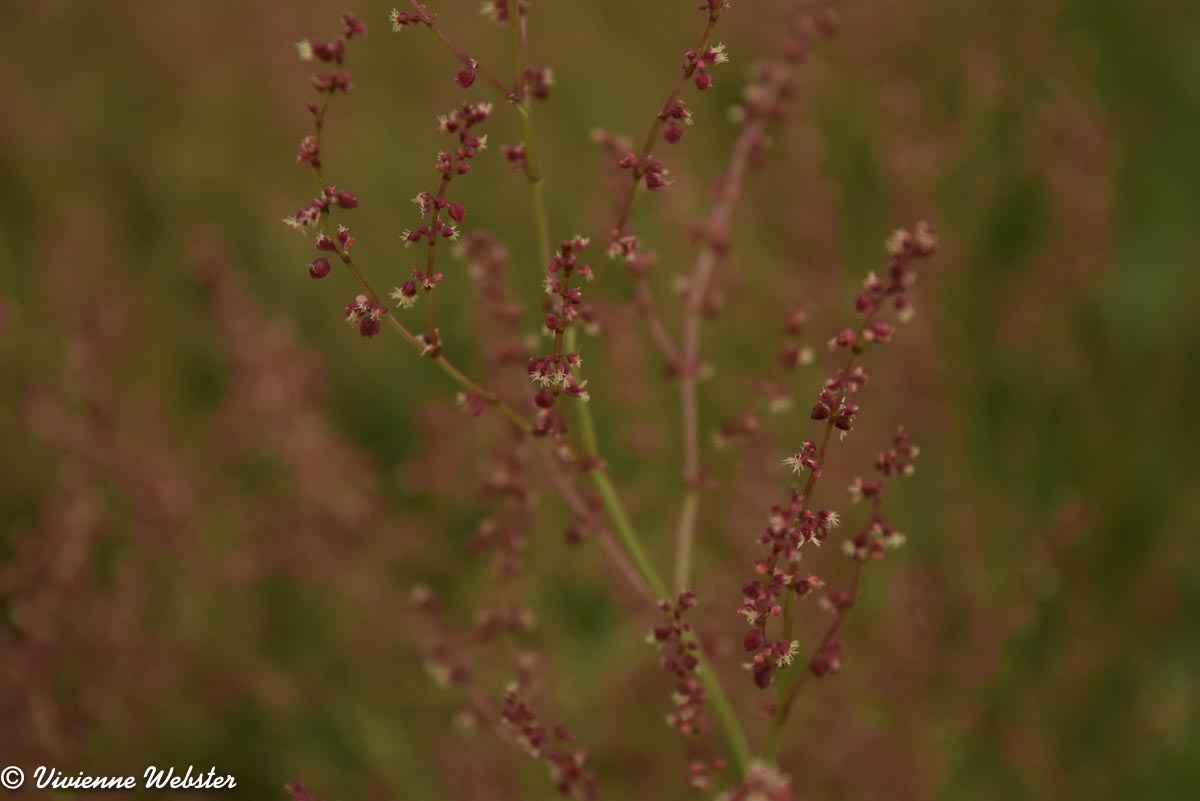
Red dock, or sheep sorrel are the common names.
Other more familiar flowers appeared mixed in with the long grass. There was orange hawkweed, or the devil’s paintbrush as some people call it. (Pilosella aurantiaca)
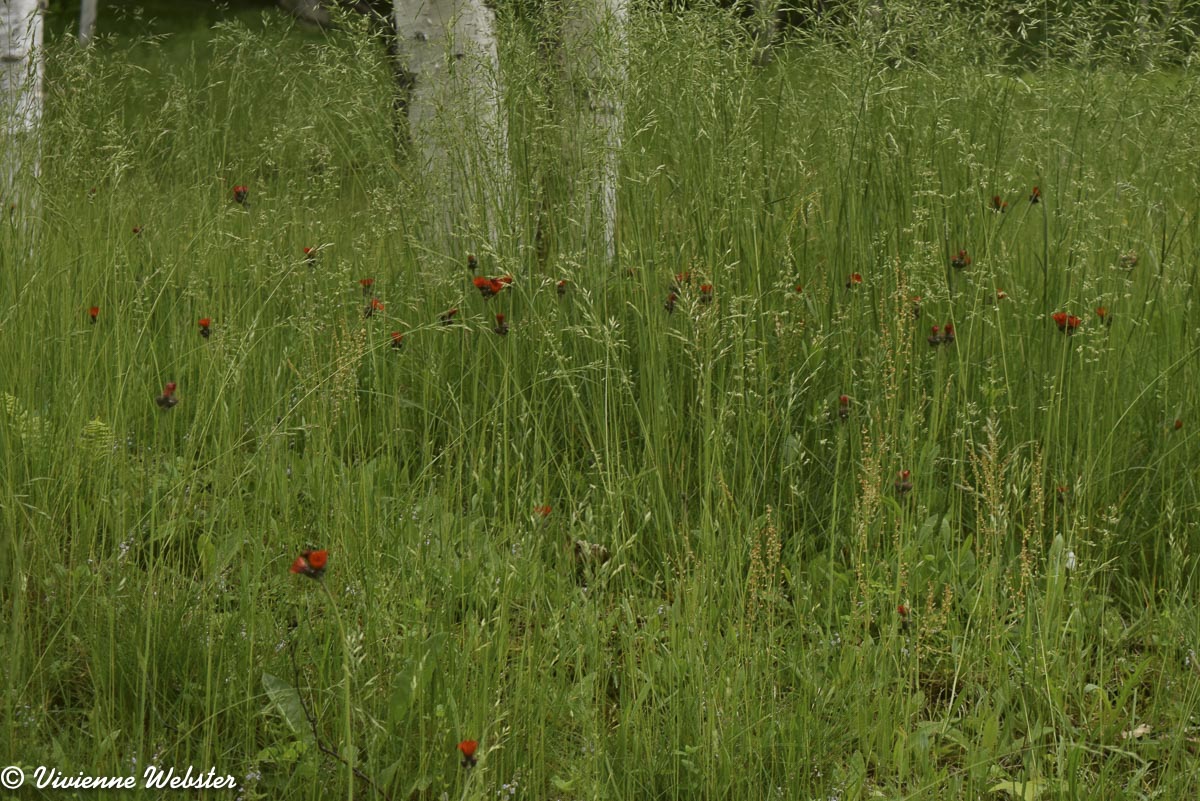
Growing around a birch tree and mixed with a variety of grasses, orange hawkweed offers a nice contrast in colour and texture.
There were great spreads of ragged robin (Lychnis flos-cuculi) and forget-me-nots (Myosotis)…
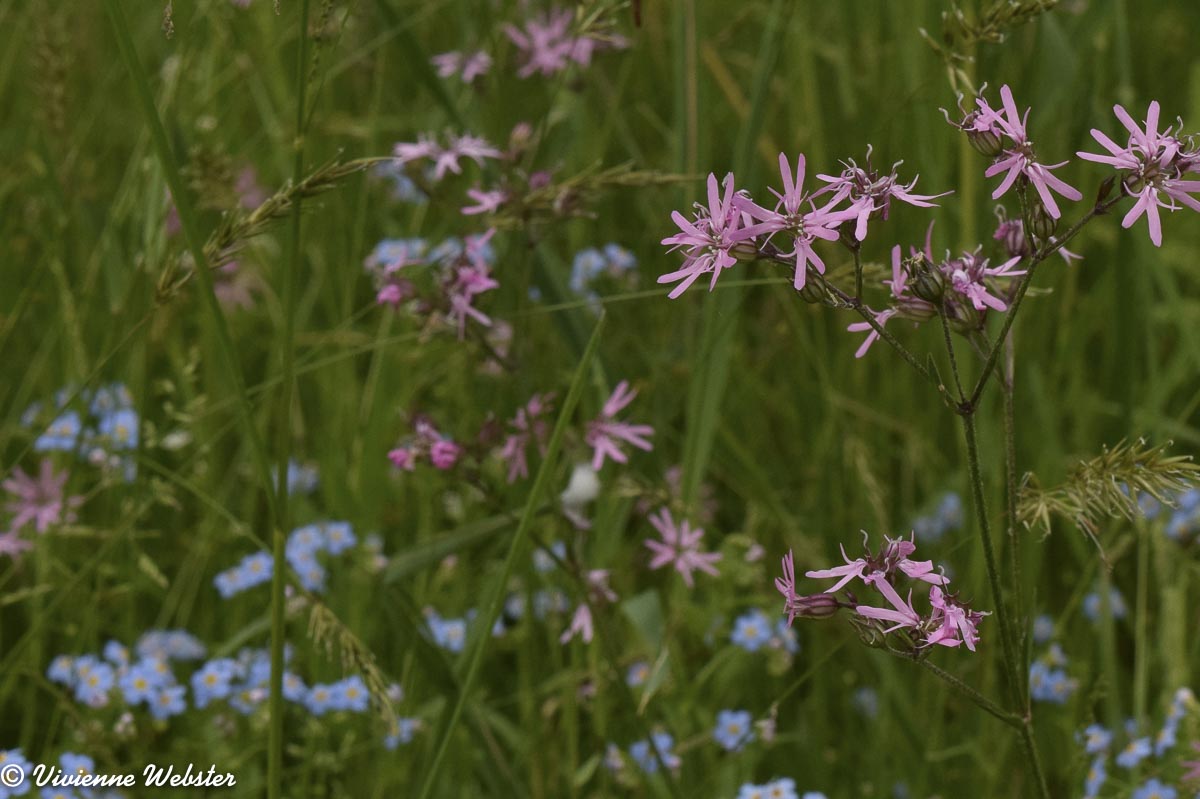
Will the dock be more vigorous than the ragged robin and forget-me-nots, or will they live happily side by side?
…patches of sunny-topped dandelions (Taraxacum)…
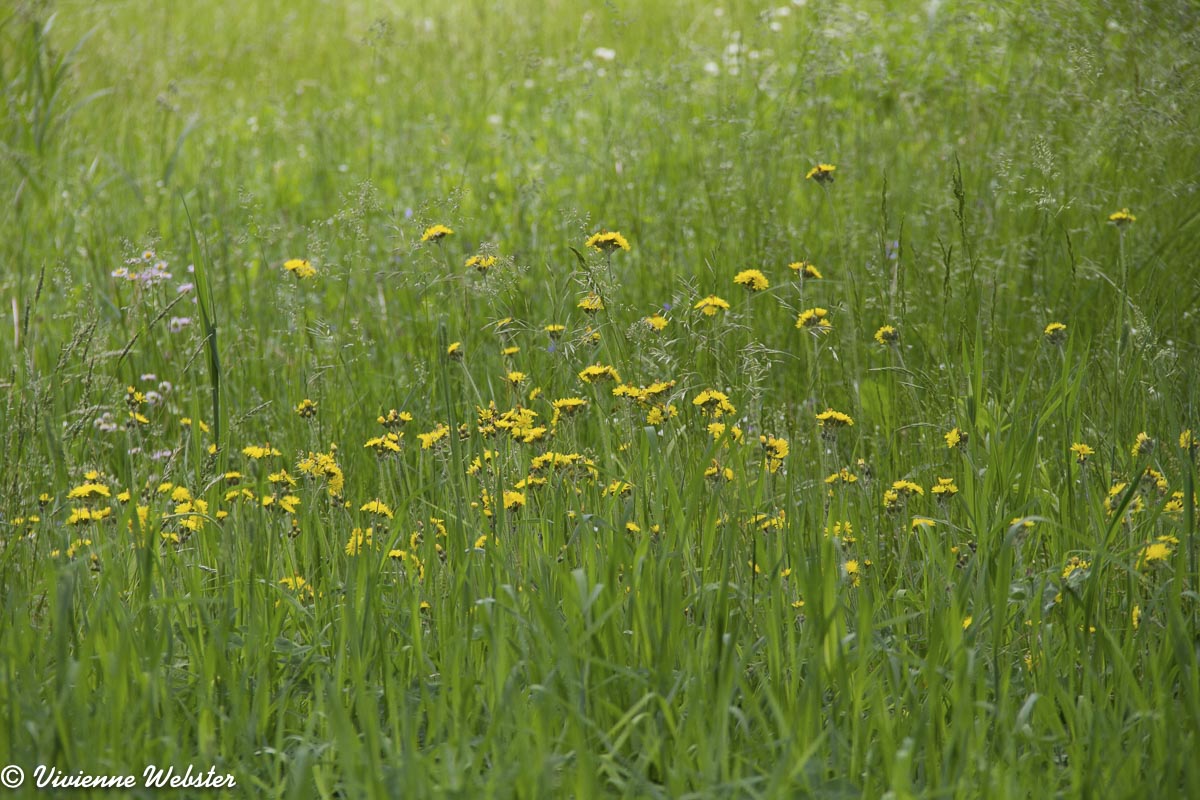
Who says dandelions should be dug out of lawns? Not me.
… and grasses that were lovely on their own.
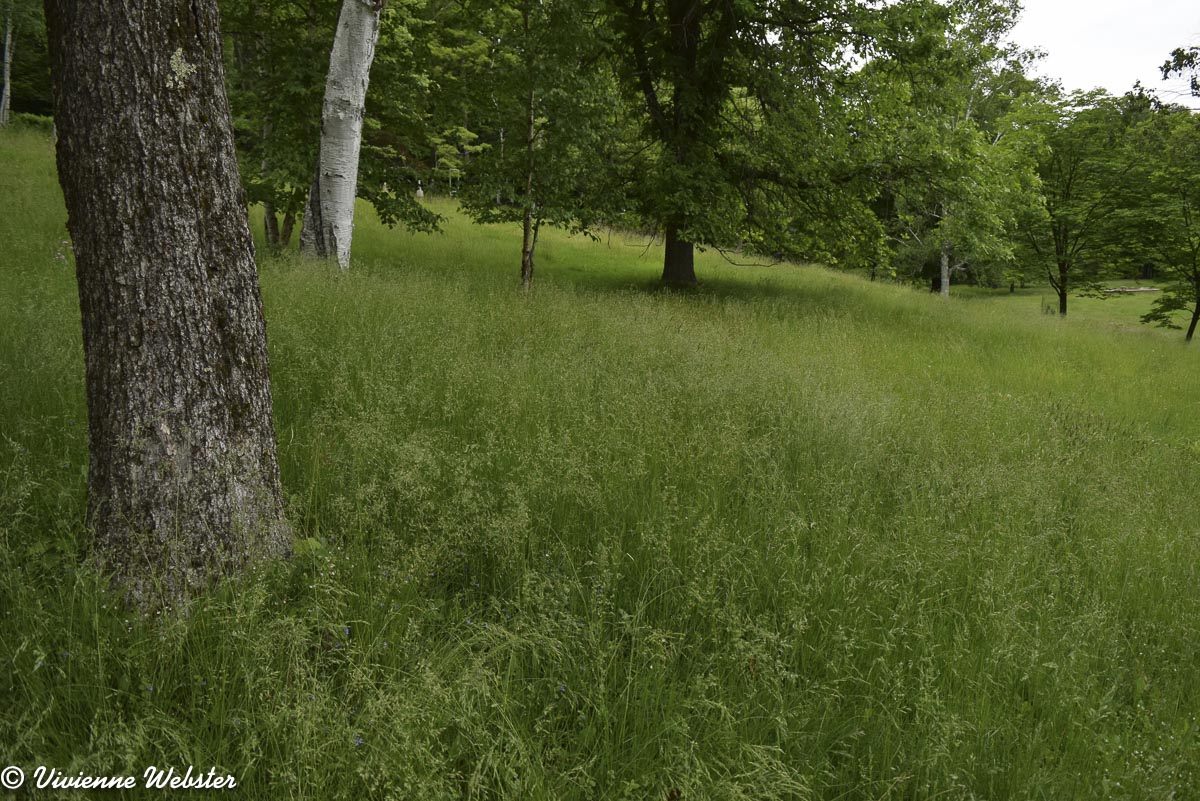
Another nice composition by Vivienne.
Surprises appeared. Some were good surprises, like this white flower that I have’t managed to identify.
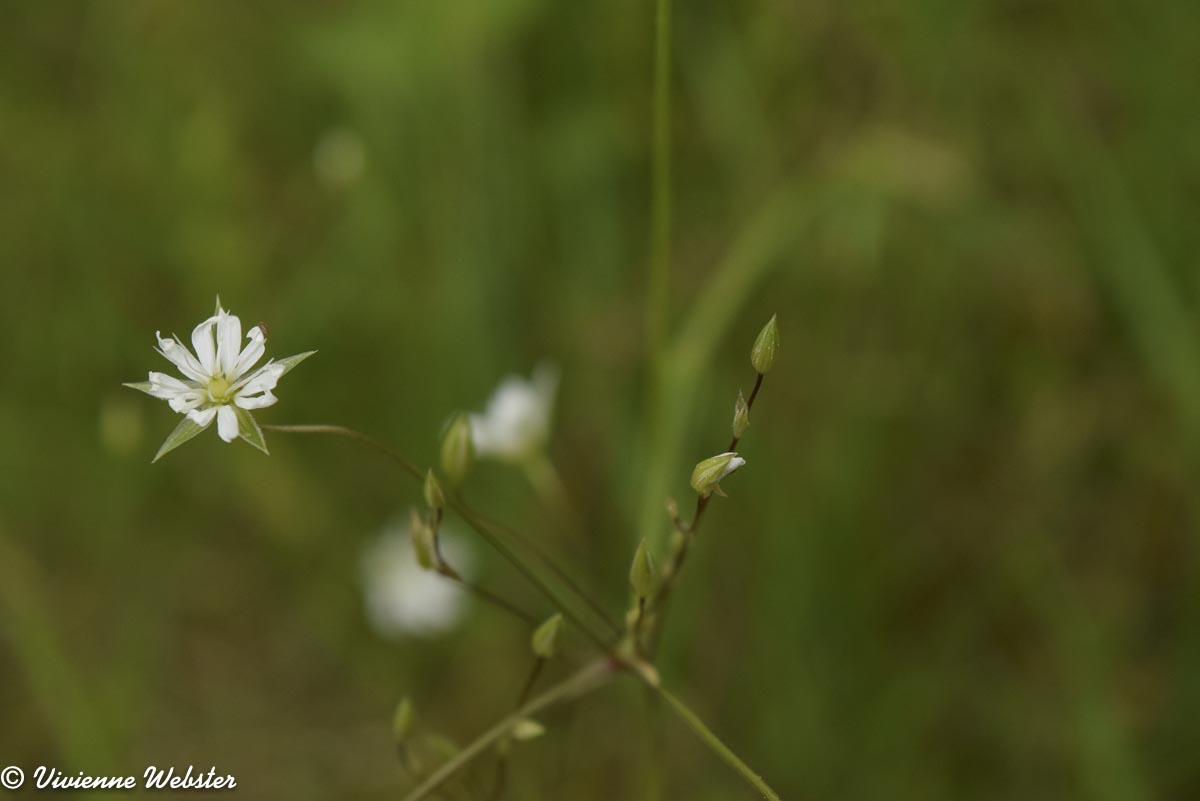
I think Vivienne’s photos are stunning. Do you agree? Or am I only a proud grandmother?
Others were not. Because it turns out that Canada geese can recognize a path when they see one. And that’s where they are choosing to walk.
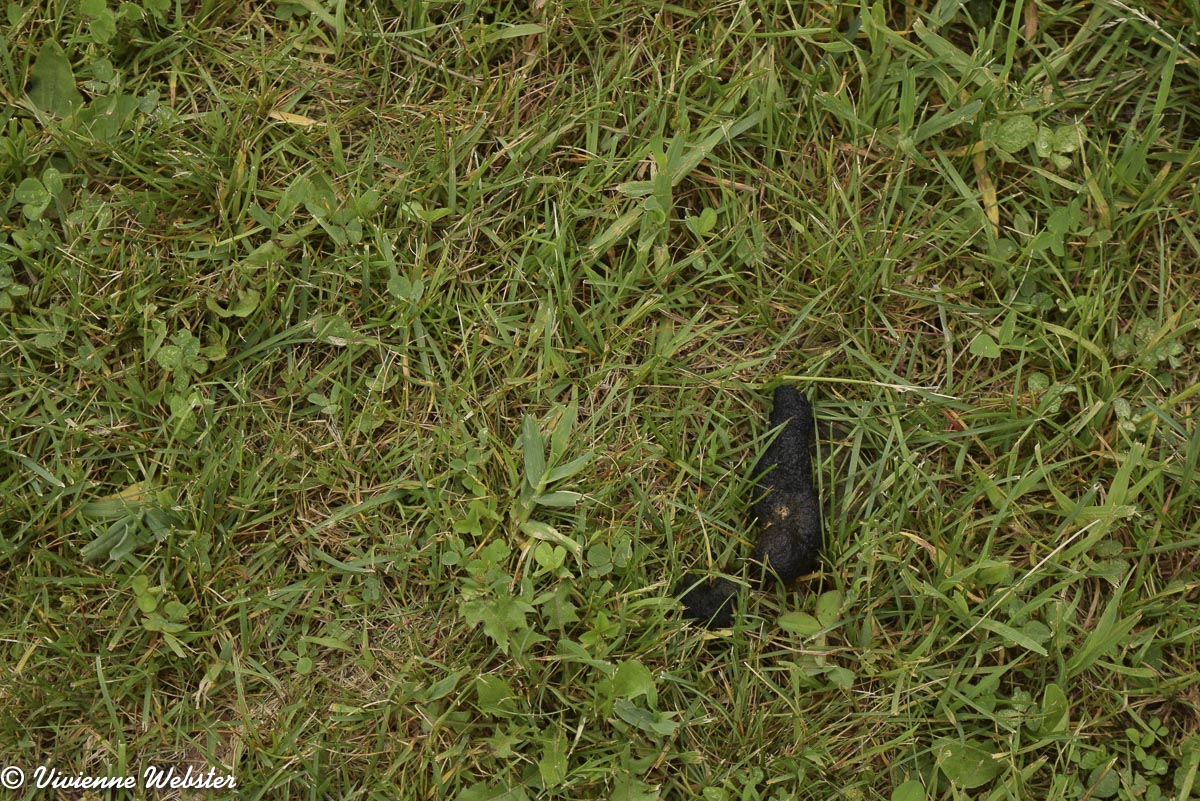
Do I need to identify this?
I’m told there were 50 or more of them one day while I was away, but since I returned, I’ve seen only what they left behind. We may have to spray the path, or leave it to grow as well. Based on what I saw over the weekend, and what Vivienne photographed, a field with no paths wouldn’t be a bad thing.

An almost 8 year-old granddaughter, photographed by her cousin, 14 yr old Vivienne Webster. (Or 14 1/2, as she insists on mentioning.)
This first year of the conversion from lawn to meadow is going as well as I could hope. I plan to post monthly up-dates as the summer progresses. I also hope to introduce selected wildflowers that I’m starting from seed. If you have ideas or suggestions for any aspect of this project, please share them. It’s an experiment and since I can’t predict what will happen, I welcome your input.






What you are calling dandelion may actually be yellow hawkweed. Are the stems hollow tubes or solid? What do the leaves look like? The last white flowered plant looks like chickweed to me. And the leaves of the Rumex are edible. My kids called it sour grass even though it doesn’t look grass-like. It is a real pita in a garden bed, but I can see why you like it in the field. Question: what is the difference (if there is any) between a meadow and a field?
We have lots of yellow hawkweed in the woods above the lawn so you are probably right. Since Vivienne took the photo, I didn’t look at it closely, in the flesh (in the grass?) or in the picture.
The difference between a meadow and a field: hmmm… they may look the same but one sounds agricultural and the other photogenic!
Dandelions are great for bees….https://www.google.ca/url?sa=t&rct=j&q=&esrc=s&source=web&cd=3&cad=rja&uact=8&ved=0ahUKEwj924GozajNAhVG42MKHZGdDTcQFggxMAI&url=http%3A%2F%2Fwww.cbc.ca%2Fnews%2Fcanada%2Fbritish-columbia%2Fdandelions-lawn-bees-1.3526394&usg=AFQjCNGoUTruilK68ZPeT64j_t3o_kMIdA&sig2=fabVc0-_ualvWyyzJN4yXQ
And great for wine. Or so I’m told.
I love that last picture of your granddaughter. Perhaps deter the geese with a much narrower path? Your meadow is evolving nicely.
I agree that the path could be narrower, if only the mower were! I also love the picture of my granddaughter. It is full of the delight of childhood.
I like your meadow-in-progress. This year, I have been ignoring a sandy back-filled area at the front of my house which I won’t get to landscape for another couple of years and I’ve been amazed at the variety of grasses and wildflowers (along with some self-sown seedlings of garden perennials) that have come up there. I’ve decided to just enjoy it and not bother trying to cut it back.
Isn’t it wonderful when nature gardens for us? I’m in touch with several people around the world who are doing something similar. Different growing conditions mean that different approaches are sometimes necessary but the results seem to be much the same. Encouraging wildflowers and grasses may be the newest trend in garden design.
I love it. I’ve done the same thing with my small suburban back yard, and I’m amazed at what comes up in the grass (orange hawkweed is my favorite). Meadows don’t need to be planted, as long as you don’t want a really high proportion of colorful flowers.
I would try to keep the path; it’s beautiful in your second photo.
Thank you, Cindy. What I find fascinating are the changes, week to week. There are now large sections of silvery grasses mixed with sections of different shades of green and gold. It’s quite magical. And I agree, the path is important, both visually and to make the area easily accessible.
What an excellent idea to repel the wretched geese, revealing some lovely surprises (as well as the inevitable dock). I have orange hawkweed popping up unbidden in a flowerbed and decided to leave it as a bright counterpoint to some more demure garden plants. And what charming pictures Vivienne has taken – she appears to have inherited your eye! (Oh, and the difference between a meadow and a field is – according to Chambers – a meadow is a level tract producing grass to be mown down or a rich pasture-ground, esp. beside a stream as opposed to a pice of ground enclosed for tillage or pasture or sport, so meadow it is!)
I like the differentiation between meadow and field. Next week I think I’ll write about the lawn to meadow transformation again. A month is making an enormous difference.